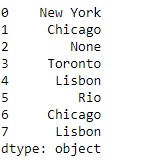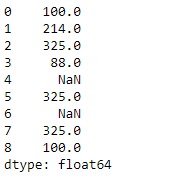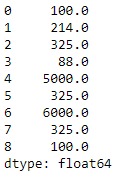Python是进行数据分析的一种出色语言,主要是因为以数据为中心的python软件包具有奇妙的生态系统。 Pandas是其中的一种,使导入和分析数据更加容易。
Pandas 系列是带有轴标签的一维ndarray。标签不必是唯一的,但必须是可哈希的类型。该对象同时支持基于整数和基于标签的索引,并提供了许多方法来执行涉及索引的操作。
Pandas Series.update()函数使用传递的Series对象中的非NA值在适当位置修改Series。该函数按索引对齐。
用法: Series.update(other)
参数:
other:系列
返回:没有
范例1:采用Series.update()函数以更新给定Series对象中某些城市的值
# importing pandas as pd
import pandas as pd
# Creating the Series
sr = pd.Series(['New York', 'Chicago', None, 'Toronto', 'Lisbon', 'Rio', 'Chicago', 'Lisbon'])
# Print the series
print(sr)输出:

现在我们将使用Series.update()函数更新标识给定Series对象中传递的索引的值。
# update the values at the passed index
# from the values in the passed series object
sr.update(pd.Series(['Melbourne', 'Moscow'], index = [2, 7]))输出:

正如我们在输出中看到的,Series.update()函数已成功通过传递的系列对象更新了原始系列对象中的值。
范例2:采用Series.update()用于更新给定Series对象中某些元素的值的函数
# importing pandas as pd
import pandas as pd
# Creating the Series
sr = pd.Series([100, 214, 325, 88, None, 325, None, 325, 100])
# Print the series
print(sr)输出:

现在我们将使用Series.update()函数更新标识给定Series对象中传递的索引的值。
# update the values at the passed index
# from the values in the passed series object
sr.update(pd.Series([5000, 6000], index = [4, 6]))输出:

正如我们在输出中看到的,Series.update()函数已成功通过传递的系列对象更新了原始系列对象中的值。
相关用法
- Python pandas.map()用法及代码示例
- Python Pandas Series.str.len()用法及代码示例
- Python Pandas.factorize()用法及代码示例
- Python Pandas TimedeltaIndex.name用法及代码示例
- Python Pandas dataframe.ne()用法及代码示例
- Python Pandas Series.between()用法及代码示例
- Python Pandas DataFrame.where()用法及代码示例
- Python Pandas Series.add()用法及代码示例
- Python Pandas.pivot_table()用法及代码示例
- Python Pandas Series.mod()用法及代码示例
- Python Pandas Dataframe.at[ ]用法及代码示例
- Python Pandas Dataframe.iat[ ]用法及代码示例
- Python Pandas.pivot()用法及代码示例
- Python Pandas dataframe.mul()用法及代码示例
- Python Pandas.melt()用法及代码示例
注:本文由纯净天空筛选整理自Shubham__Ranjan大神的英文原创作品 Python | Pandas Series.update()。非经特殊声明,原始代码版权归原作者所有,本译文未经允许或授权,请勿转载或复制。
